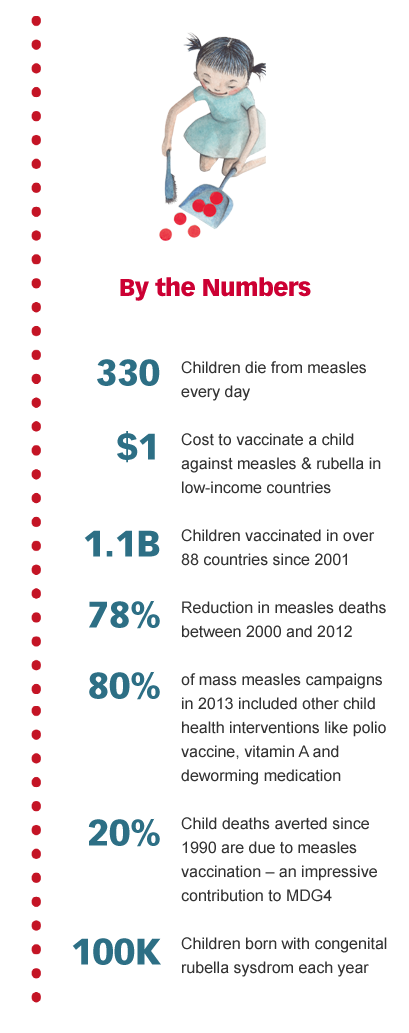2014 Fact Sheet
- Home>
- Resources>
- Advocacy Tools>
- 2014 Fact Sheet
The Measles & Rubella Partnership is a global partnership committed to ensuring no child dies from measles or is born with congenital rubella syndrome.
Since 2001, the Partnership has been led by the American Red Cross, United Nations Foundation, U.S. Centers for Disease Control and Prevention, UNICEF and the World Health Organization.
![]()
Measles is a leading cause of death among children despite the fact that a safe and effective vaccine has been available for over 50 years.
More than 20 million people are affected by measles each year, particularly in parts of Africa and Asia.
Measles is life threatening in developing countries where children have limited or no access to medical treatment, and are often malnourished.
Measles costs money, time and lives. During outbreaks, public health authorities spend time tracing potential contacts, answering calls from the public and money treating people in hospital. Sick children stay home from school and parents stay home to care for them.

Measles outbreaks are particularly deadly during emergency settings in communities experiencing, or recovering from conflict or natural disaster. Overcrowding in refugee or internally-displaced camps greatly increases the risk of measles transmission and complications.
Rubella is generally a mild illness but when pregnant women become infected, particularly during the first trimester of pregnancy, there is a 90% chance of the fetus having congenital rubella syndrome (CRS) – the baby can be born with multiple defects including heart disorders, blindness, deafness or brain damage.
Measles and rubella can be prevented with a safe, effective and inexpensive vaccine which can be delivered alone, combined, or as the measles, mumps and rubella vaccine.


 During the 2012 World Health Assembly, 194 countries adopted the Global Vaccine Action Plan committing to measles elimination in four WHO regions, rubella elimination in two WHO regions by the end of 2015, and the elimination of both measles and rubella in five WHO regions by the end of 2020.
During the 2012 World Health Assembly, 194 countries adopted the Global Vaccine Action Plan committing to measles elimination in four WHO regions, rubella elimination in two WHO regions by the end of 2015, and the elimination of both measles and rubella in five WHO regions by the end of 2020.
Eliminating measles and rubella requires reaching every child to protect them against both diseases, including the poor and marginalized.
Global progress in the last decade against measles has been stunning:
- All 35 countries in the Americas eliminated measles in 2002.
- Measles vaccine reaches more than 8 in 10 children globally.
- 211 million children received measles-containing vaccine during mass
campaigns held in 33 countries in 2012. - The Western Pacific Region, with more than 1.8 billion people including
China, reduced measles cases by 84% between 2009 and 2012 and is
now on the verge of measles elimination. - Sub-Saharan African countries have made the most progress and have
reduced measles deaths by 88%.

![]()
In 2012, the Strategic Advisory Group of Experts determined that at the current pace, three WHO regions (Africa, Eastern Mediterannean and Europe) are not on track to achieve their regional elimination goals with large outbreaks occurring throughout these regions.
More than 21 million children were not reached with measles vaccine in 2012 and over half of them live in just six countries: the Democratic Republic of the Congo, Ethiopia, India, Indonesia, Nigeria and Pakistan.
To reach 2020 elimination goals, necessary financial resources must be secured to ensure timely and high quality measles and rubella activities. There must be renewed political commitment in priority countries to ensure adequate vaccination coverage to protect every child.






















 Prelude Version 2.3.2
Prelude Version 2.3.2